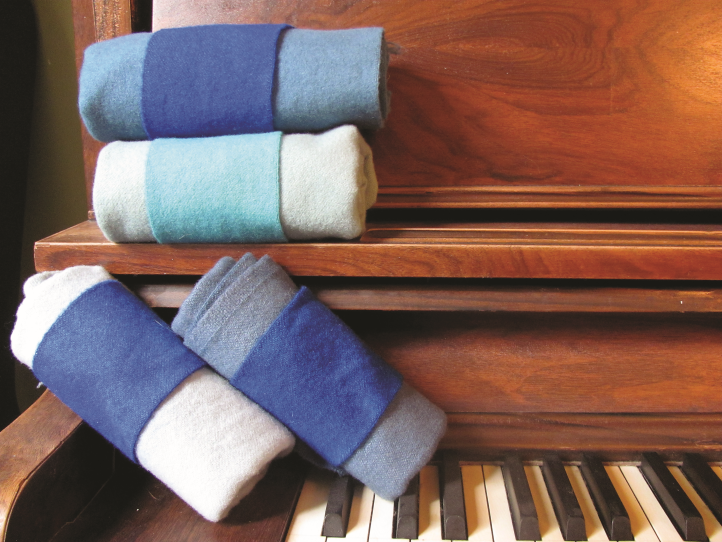
I loved playing with the blues, and I hope you will too.
Sometimes when I need to make blue, I get the blues! Many of our blue dyes are very bright. And unless we want to buy toned down blue dyes for an array of purposes—one for skies, one for old-fashioned rugs, one for night skies, and so on—it would help a great deal to know how to use the blues we have. The knowledge of how to take a very bright blue dye straight from the package and transform it into the blue we need is very valuable.
When I first learned to dye, I bought many more blues than any other dye. I was on a search for the “best” blue to create my rugs. I wish I had known then that I could mix most any color I needed by adding to the blues I already had.
PICK A BLUE, ANY BLUE
I want to show you how you can take any blue dye and, with careful consideration, transform it into workable, wonderful, fit-in-anywhere blue for rug hooking. So I went straight to my dye cabinet to grab a blue from each company of dyes I use. Here’s what I found:
- Majic Carpet Blue
- PRO Chem Brilliant Blue 490
- Aljo Alzarian Fast Cyanine Blue
- Cushing Aqualon Blue
It doesn’t happen very often that dye companies have a crossover color, but this Aljo blue is a complete doppelganger for PRO Chem’s National Blue, one of my favorite blues. And a note about Cushing Aqualon Blue: it’s really turquoise. Undaunted by the challenge, I decided to do just as you would: use what you have at hand, finding a way to get from point horrible to point wonderful with the blues in my house.
THE DYE PROCESS
I made samples of each of these dye colors by dyeing 1/32 tsp. of dye over 1/32 yard of wool. To get 1/32 yard of wool, simply divide 1/8 yard into four even sections. I’ve had people say they only want to dye 1/64 tsp. dye over the 1/32 yard of wool, but I like to see the full saturation of the dye, and my formula seems to get me there.
I dye my samples in jars in a bain marie (water bath). I start off with the water in both the pan and the jar cold, with the dye and wet wool together in the jar. I stir vigorously and frequently for even color application. I do not add acid until almost all the dye is taken up. I then add about 1/64 tsp. to 1/32 tsp. to each jar, again stirring frequently for even results.
I know I’ve told you before, and at the risk of nagging like a fishwife, I’m going to say it again: dye samples of all your dyes. You will learn so much. You will know what those dyes look like at your house with your equipment and water and measuring tools. They make wonderful references. Keep a small piece to refer to as a visual aid in a journal, tape a small piece in a handy chart to have beside you as you dye, or even paste a piece right on your dye jars or envelopes.
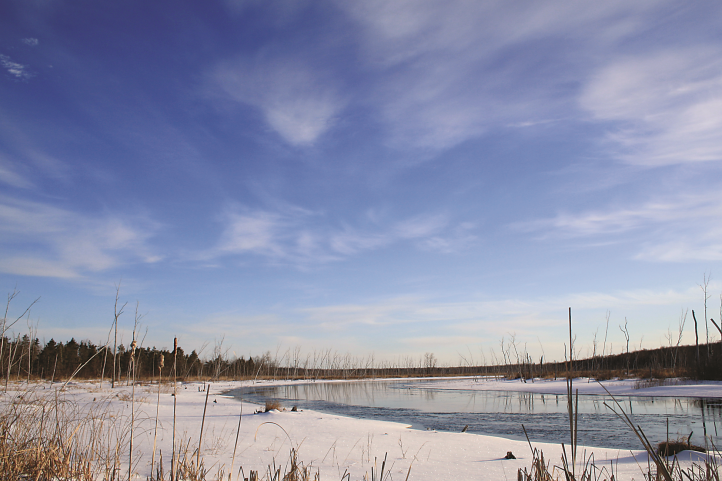
There is a lot of sky and water where I live. After a lot of searching, I found this photo of Pike River to inspire me.
SCENERY BLUE
Take a careful look at the photo of Pike River. I divided the photo into four even sections, and I will use one of the dyes on hand in each section to create one blue I need.
We have a lot of rote sayings about the behavior of water and sky and how to hook them, but these tidbits seldom prove out in reality. Notice how the water does not reflect the sky with the same hue; it is not blue but turquoise. It is reflecting the lower end of the distant sky due to our vantage point. Attentive study of reference material and natural scenes makes for a successful rug as well as successful dyeing sessions.
Let’s take a look at how I’ll use my blues:
- You can see how my Aqualon Blue is going to prove very helpful in the lower right-hand quadrant. I would be foolish if I didn’t use this happy accident to my advantage. I will be using Aqualon Blue’s natural tendency toward green to the best advantage.
- Look how dark and rich the upper left-hand section is. Most rug hookers would not advise us to have such a dark section in a day sky, but there it is: the evidence is right before us. I’m going to use PRO Chem here because my bunions told me to. Sometimes it really is that arbitrary.
- The lower left-hand quadrant has some lovely gray in the snow and the low cloud, so we can practice the dull lights and mediums using blues. I’ll use my Aljo Alzarian Fast Cyanine Blue.
- The upper right-hand side has a wonderful violet property. I’ll be using the PRO Chem Bright Blue 490 as a starting point.
NOTE: For all the recipes below, I dyed 1/4-yard pieces of natural wool in a regular dye bath method. I dyed the wool without adding acid until most of the color had taken up. I made adjustments if needed before I added my acid. At this point, I added 1/64 tsp. acid. I add more acid for darker colors, less for light.
I know you can do it! I might not hear you playing the blues, but I hope to see it in a rug someday! Start playing today. Practice makes perfect. In the case of dyeing, practice leads to deeper understanding.
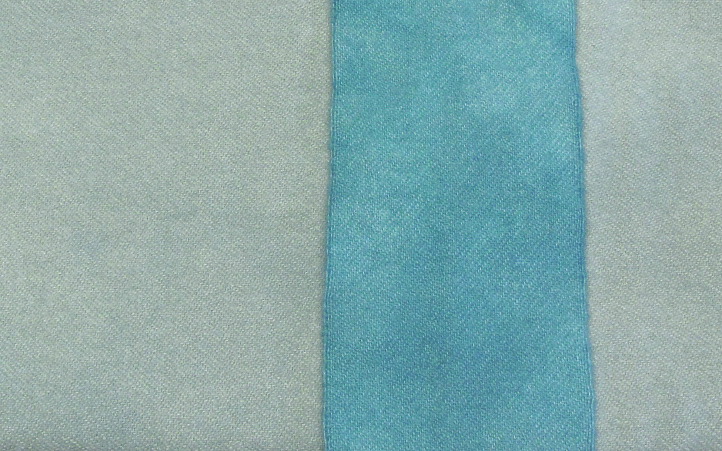
Cushing Perfection Dye
Cushing Perfection Dye
The dye color is overlaying the formula color.
1/32 + 1/64 tsp. Aqualon Blue
1/64 tsp. Silver Gray
1/128 tsp. Medium Brown
Adjustment: 1/4″ damp toothpick into any—and I mean any—blue dye that’s bright into the dye bath with the wool removed; wait until it dissolves then add wool back in.
Add 1/32 tsp. citric acid.
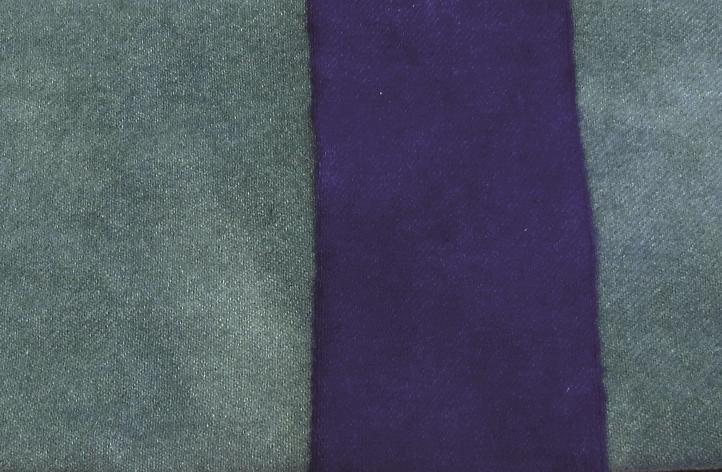
ProChem WashFast Acid Dye
ProChem WashFast Acid Dye
The Brilliant Blue sample overlays the formula.
2/32 tsp. 490 Brilliant Blue
1/64 tsp. 230 Spiced Pumpkin
Adjustment: 1/128 tsp. Brilliant Blue
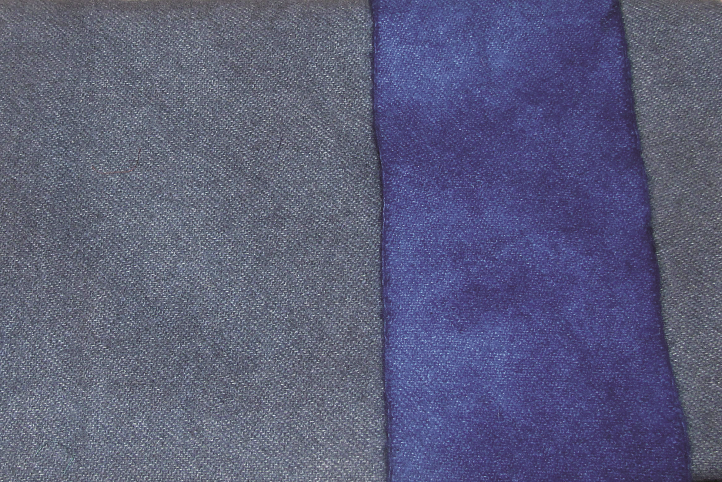
Majic Carpet Dye
Majic Carpet Dye
Dyed sample of Majic Carpet Blue overlays the formula.
2/32 tsp. Blue
1/64 tsp. Black
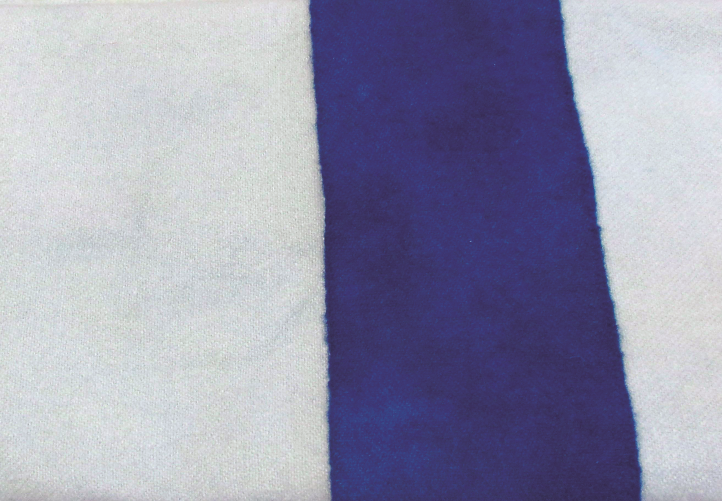
Aljo Dye
Aljo Dye
The sample of straight dye color overlays the formula.
1/64 tsp. Alzarian Fast Cyanine Blue
3/4″ damp toothpick of Golden Brown
Adjustment: 1/4″ damp toothpick Aubergine 1/4″ damp toothpick Royal Blue
BONUS BLUES: NAVY AND TEAL AND MORE, OH MY
To create a beautiful navy, simply use 2 parts blue (bright and dark like most of our samples) to 1 part black. You can add variations by adding 1/2 part turquoise to make a dark teal or adding 1/2 part violet or blue violet to make an interesting warm navy.
Ratios are a great way to get lighter and darker values by simply changing your dye spoon or measurement tool. To explain how the ratio system works:
- Using 1/4 yd. wool, let your base measure be 1/4 tsp. to create a dark color. That means we would have a recipe calling for 2 parts blue and 1 part black. Your recipe would be 1/2 tsp. blue and 1/4 tsp. black.
- If you are trying the teal or warm navy, use 1/8 tsp. of one of the variation colors.
I have not given you a sample of this navy. I want you to use this as a jumping off point to spread your wings. If you find it is not dark enough, do the recipe again over the same wool. This will increase the darkness by one value. You can do it!
For even more colors, use the scenery blue recipes and try some of these extras: dip one end into a weak black dye bath, then dip the other end into a complementary color (you will only need a few grains of dye for this) to see what will happen for future dye days. Blue is the coolest color on the color wheel. No matter which way you go from blue, you are getting warmer. Maybe you could rip a strip in half and dip one end in brown, the other in violet (stepping away from blue in the warm direction) or orange.
What a wonderful learning opportunity you could have, and it is so pleasurable to see the range of results, even in close colors, like red and orange.
DYE NOTES
- During this dye session, I created fraternal twins. The lighter ones are leaning slightly towards green on the color wheel.
- With dull colors, it is easy to influence their appearance by the colors that will surround them.
- These sets would make great mixing colors for a simpler rug plus create a good set of uppers and lowers on landscapes with water and sky, as we are doing here.
- Sometimes you need to be bold. I had to use 4 times the amount of Cushing Aqualon Blue to reach the same values as the other light color from Aljo Dye.
- Using orange derivatives like brown can effect interesting dulling of the brights but also create a greening effect.
- It is easy to correct a greenish blue by looking to the other side of blue on the color wheel and adding some blue violet.
- It is easy to correct a blue with a violet leaning by adding some blue green. But be cautious: don’t add too much at any time, especially if you want to retain a certain value. Each time you add dye your wool becomes darker.
- Black remains a great way to knock back the high bright blue, especially for skies and water.
